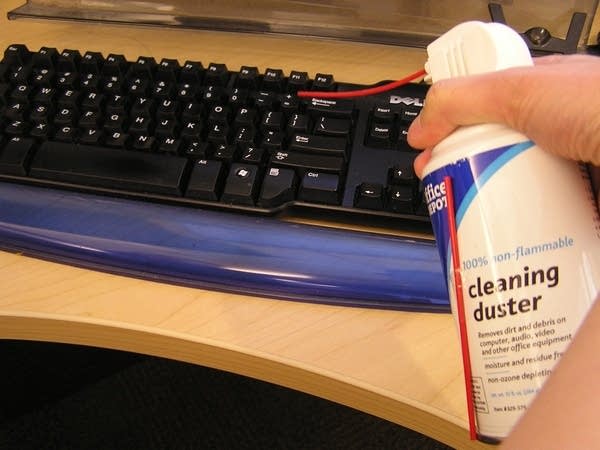New laws take small steps to address global warming
Go Deeper.
Create an account or log in to save stories.
Like this?
Thanks for liking this story! We have added it to a list of your favorite stories.

The next time you reach for that spray can to clean your computer keyboard, you might want to take a few seconds to read the contents. A lot of these cleaners contain chemicals like hydroflourocarbons -- HFCs -- that, pound for pound, are much more potent greenhouse gases than carbon dioxide, emitted by cars and power plants.
Another place you'll find them is in your car air-conditioner. Similar chemicals are used in medicine and industry.
Kevin Reuther, with the Minnesota Center for Environmental Advocacy, worked on legislation to begin to phase them out.
"One of them, called SF6, sulfur hexaflouride is actually 23,000 more potent than carbon dioxide," he says. "So if you have one pound of SF6, it's equal to 11 tons of carbon dioxide," says Reuther.
Turn Up Your Support
MPR News helps you turn down the noise and build shared understanding. Turn up your support for this public resource and keep trusted journalism accessible to all.
In quantity they're just a drop in the bucket, he says, but because they warm the atmosphere so much, it's important to start to eliminate them.
The law requires industry to report to the Minnesota Pollution Control Agency each year, how much of these chemicals they produce and purchase. It also requires auto makers to publish the leakage rates of their air-conditioning systems and it directs the MPCA to report on ways to reduce these emissions.
You may remember a few years ago when car air conditioners used Freon, which contributed to a hole in the ozone layer. The HFCs were a substitute for Freon. The European Union is pushing scientists to find better substitutes, Kevin Reuther says.
"So we're sort of looking for a third substitute in a way," Reuther says. "Something that won't affect the ozone layer and won't contribute to global warming."
Substitutes should be available in about five years. In the meantime, he says we should make sure our car air-conditioners aren't leaking. In Wisconsin, you can't buy small amounts of HFCs and fill the air conditioner yourself. Reuther wanted that kind of ban in Minnesota, but it was dropped from the bill.
Another measure that slipped through without much controversy is aimed at dramatically cutting the energy used in commercial buildings. There's a huge potential to reduce greenhouse gas emissions that way, according to Sheldon Strom, who directs the Center for Energy and Environment.
"Testimony at the legislature by a number of architects showed that we can build much better buildings than we're currently building," Strom says. "And we can have those improvements pay for themselves in five years or less."
"We can build much better buildings than we're currently building, and we can have those improvements pay for themselves in five years or less."
The voluntary standards would be set by experts at the University of Minnesota, working with builders and utilities. Over time the standards would get tighter.
Builders can already meet the standards for 2010, using existing technologies and methods, Strom says, and they should pay for themselves in five years or less.
"As we get more aggressive, in 2015 and 2020, it may be more difficult," he says. "But the idea is that energy costs are likely to be rising, and that technology is likely to be improving."
And how -- you might ask -- will all this work if the standards are only voluntary? The law involves a group that's getting very good at figuring out how to save energy -- the electric utilities, Strom says.
"Utilities in Minnesota would be required to offer a whole range of services and incentives that would make it very easy for private sector to comply with these standards," he says.
Last year the legislature mandated that electric companies reduce their sales by 1.5 percent a year. The savings they help builders achieve in these new energy-efficient buildings will count as part of their required reduction.
The standards are mandatory for buildings paid for with state bonding money.
Both of these ideas were recommended by the governor's task force on climate change. Gov. Pawlenty has signed them.



